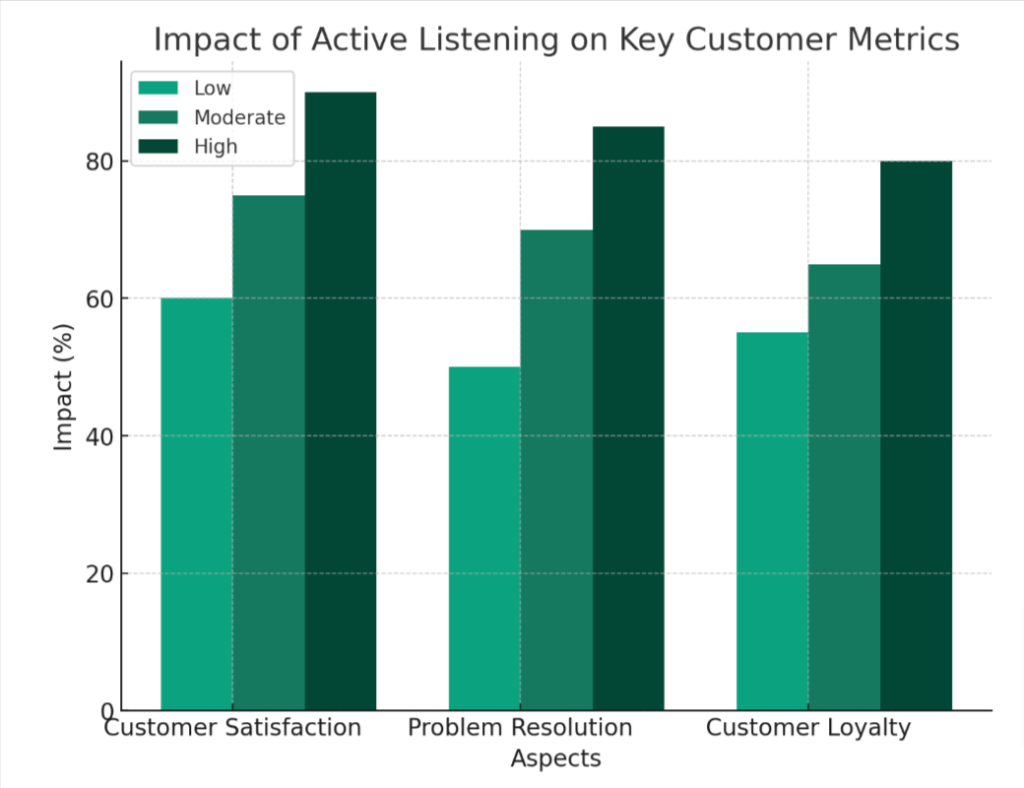Mastering Active Listening in Live Chat: A Guide to Better Communication
Ever had a chat with customer service that felt more like talking to a wall? Studies show effective listening can solve up to 50% of customer complaints before they escalate. This blog post guides you through mastering Active Listening Skills for engaging and solution-driven live chats.
Keep reading; it’s easier than you think!
Key Takeaways
- Active listening involves fully focusing on what the customer is saying, understanding their words and feelings, responding appropriately, and remembering the conversation.
- Training in active listening skills can improve live chat support by helping agents effectively engage with customers and solve problems faster.
- Nonverbal cues like typing speed and use of emojis are important in live chats to gauge a customer’s mood or urgency.
- Avoiding assumptions, being empathetic, not getting defensive, eliminating distractions, giving constructive feedback, and recognizing good listening habits are key to better communication during live chat interactions.
What is Active Listening?
Active listening is the practice of fully concentrating, understanding, responding to, and remembering what is being said in a conversation. It’s an essential skill for effective communication and building strong relationships with customers.
Definition and importance
Active listening is a vital communication skill that involves fully concentrating, understanding, responding, and then remembering what the other person is saying. It’s much more than just hearing the spoken words; it encompasses paying close attention to nonverbal cues like tone of voice and body language.
This level of engagement helps build stronger connections with customers by showing you care about their needs and concerns.
This deep listening forms the foundation for successful customer service interactions, especially in live chat where visual cues are absent. By actively engaging in dialogue and demonstrating understanding through verbal communication, service reps can solve problems more effectively and ensure that every customer feels heard and valued.
Mastery of this technique leads to improved customer satisfaction rates—a crucial metric for any business aiming to thrive in today’s competitive market. Moving forward let’s debunk some common misconceptions about active listening within this context.
Common misconceptions
Many people think active listening in live chat simply means responding quickly to customers, but it’s much more than that. It involves understanding the emotions behind the words and grasping the full message being conveyed.
Some may also believe that good listeners make perfect customer service agents from day one, yet these skills often require training and consistent practice.
Another widespread myth is that nonverbal cues don’t matter in textual conversations such as live chat. However, recognizing subtleties like typing rhythm or the use of emojis can offer clues about a customer’s mood or urgency.
Others assume active listening disrupts workflow efficiency by taking too much time, when in reality, it can actually streamline problem-solving and enhance connection with customers by reducing misunderstandings and fostering effective communication.
How to Utilize Deep Listening in Live Chat Conversations
– Focus on the customer and their needs, actively engaging in the conversation.
– Be empathetic towards the customer’s situation, showing understanding and concern.
– Avoid making assumptions about the customer’s issues or concerns, ask for clarification if needed.
Focus on the customer
Paying attention to the customer’s needs and concerns is a cornerstone of exceptional service. Listening closely during live chat interactions shows that you value their time and are eager to solve their problems.
Watch for nonverbal cues like typing patterns or speed, as these can give insight into the customer’s emotional state. Using this information helps tailor your responses for a more personalized experience.
Ensure every dialogue engages customers by responding with understanding and care. Ask clarifying questions if something isn’t clear instead of making assumptions about what they need.
By concentrating on what they say, you develop a deeper connection that fosters trust and loyalty, making them feel heard and appreciated in every interaction.
Be empathetic
In live chat customer service, being empathetic is crucial for building rapport and understanding the customer’s perspective. Acknowledge their feelings and show genuine concern by using phrases like “I understand how frustrating this must be for you.” This helps to establish a connection and makes customers feel heard and valued.
Demonstrate empathy through active listening, responding with compassion, and showing a willingness to help resolve their issues. Avoid dismissive language or rushing through responses; instead, take the time to acknowledge their emotions and provide thoughtful solutions that address their concerns effectively.
Avoid assumptions
Avoid making assumptions about the customer’s needs or feelings. Instead, actively listen to their words and nonverbal cues to understand their perspective. By avoiding assumptions, you can provide a more personalized and empathetic response that meets the customer’s specific needs.
Furthermore, avoiding assumptions allows for better problem-solving and a deeper connection with the customer. This approach fosters an environment of understanding and effective communication in live chat interactions, leading to improved dialogue engagement and overall customer satisfaction.
Don’t get defensive
When engaging in live chat conversations, it is essential to avoid becoming defensive. Instead of being defensive, stay open-minded and focus on understanding the customer’s perspective.
By remaining receptive and non-defensive, you can build trust and rapport with the customer, leading to more effective communication and issue resolution.
Tips for Improving Active Listening Skills in Customer Service
Provide training, practice active listening, eliminate distractions, give feedback, and recognize good listening to improve communication skills in customer service. Want to learn more about how to become a better listener in live chat conversations? Keep reading for valuable tips!
Provide training
To improve active listening skills in customer service, it’s essential to offer comprehensive training to support team members. This helps in enhancing their ability to engage effectively in live chat conversations and provide exceptional customer support. Here are ways to provide effective training for active listening:
- Conduct workshops or seminars focused on communication and active listening techniques.
- Provide real-life scenarios and role-playing exercises to simulate live chat interactions.
- Offer coaching opportunities where employees receive feedback and guidance on their active listening skills.
- Utilize video demonstrations and case studies to illustrate effective active listening in live chat situations.
- Incorporate regular refresher courses to reinforce the importance of active listening in customer service.
Practice active listening
To improve active listening skills in live chat:
- Focus solely on the customer’s words and tone.
- Show empathy by acknowledging their emotions.
- Avoid assuming their needs or feelings; ask clarifying questions instead.
- Refrain from becoming defensive during challenging interactions.
- Train your team in active listening techniques.
Eliminate distractions
Minimize background noise, such as loud music or conversations.
Give feedback
After mastering the art of active listening, providing feedback is crucial for improving communication. Here are key strategies for giving effective feedback:
- Acknowledge the customer’s concerns and feelings to demonstrate understanding.
- Provide specific examples to highlight what was well received and what could be improved.
- Focus on constructive criticism rather than negative feedback.
- Encourage open dialogue by asking for the customer’s thoughts or suggestions.
- Offer solutions or alternative approaches if applicable.
- Ensure that the feedback is timely to address any issues promptly.
- Follow up with the customer to gauge their response and provide further assistance if needed.

Recognize good listening
Recognize good listening by acknowledging the listener’s engagement and understanding.
- Acknowledge their nonverbal cues, such as nodding or eye contact, signaling active attention.
- Notice their use of reflective statements to show they are truly hearing and processing what is being said.
- Recognize when they ask thoughtful follow – up questions that demonstrate a desire to delve deeper into the conversation.
- Appreciate when they summarize key points to ensure clear understanding and validation of the speaker’s thoughts.
- Observe their ability to refrain from interrupting, allowing the speaker to fully express themselves without feeling rushed.
- Take note of when they provide constructive feedback or support that reflects an empathetic approach to problem-solving.
- Value their efforts to maintain a customer – focused communication style, ensuring the interaction meets the needs of the individual.
Conclusion
Incorporating active listening skills into live chat conversations enhances customer service by building rapport and trust. By focusing on the customer’s needs, showing empathy, and avoiding assumptions, agents can provide more effective support.
Providing ongoing training and recognition for good listening practices can further improve communication with customers. With these strategies, businesses can cultivate a culture of attentive and empathetic dialogue engagement in their chat support interactions.

